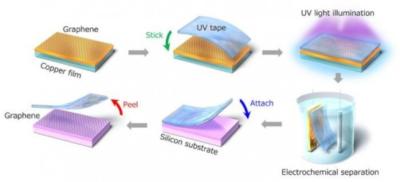Researchers from Kyushu University, Nitto Denko Corporation, Tokyo Institute of Technology, Osaka University, National Institute of Advanced Industrial Science and Technology (AIST) and Samsung Electronics have developed a tape that can be used to stick 2D materials to many different surfaces, in an easy and user-friendly way.
Transfer process of monolayer graphene from Cu(111)/sapphire to a SiO2/Si substrate using the UV tape. Image from Nature Electronics
“Transferring 2D materials is typically a very technical and complex process; the material can easily tear, or become contaminated, which significantly degrades its unique properties,” says lead author, Professor Hiroki Ago of Kyushu University's Global Innovation Center. “Our tape offers a quick and simple alternative, and reduces damage.”
The researchers began by focusing on graphene. “One of the main methods of making graphene is through chemical vapor deposition, where graphene is grown on copper film. But to perform properly, the graphene must be separated from the copper and transferred onto an insulating substrate, like silicon,” Professor Ago explains. “To do this, a protective polymer is placed over the graphene, and the copper is then removed using etching solution, such as acid. Once attached to the new substrate, the protective polymer layer is then dissolved with a solvent. This process is costly, time-consuming and can cause defects to the graphene’s surface or leave traces of the polymer behind.”
Professor Ago and his colleagues therefore aimed to provide an alternative way of transferring graphene. They used AI to develop a specialized polymer tape, dubbed “UV tape”, which changes its attraction to graphene when irradiated with UV light.
Before exposure to UV light, the tape has a strong adhesion to graphene, allowing it to “stick”. But after UV exposure, the atom bonding changes, which decreases the level of adhesion to graphene by about 10%. The UV tape also becomes slightly stiffer and easier to peel off. Taken together, these changes allow the tape to be peeled off the device substrate while leaving the graphene behind.
The researchers also developed tapes that can transfer two other 2D materials: white graphene (hBN), an insulator that can act as a protective layer when stacking 2D materials, and transition metal dichalcogenides (TMDs), a promising material for the next generation of semiconductors.
When the researchers looked closely at the surface of the 2D materials after transfer, they saw a smoother surface with fewer defects than when transferred using the current conventional technique. Upon testing the materials’ properties, they also found that they were more efficient.
Transfer using UV tape also offers various other advantages over current transfer techniques. Because the UV tape is bendy, and the transfer process doesn’t require the use of plastic-dissolving solvents, flexible plastics can be used as the substrate of the device, expanding potential applications.
“For example, we made a plastic device that uses graphene as a terahertz sensor. Like X-rays, terahertz radiation can pass through objects that light can’t, but doesn’t damage the body,” Professor Ago says. “It’s very promising for medical imaging or airport security.”
What’s more, the UV tape can be cut to size so that only the exact amount of 2D material needed is transferred, minimizing waste and reducing cost. 2D layers of different materials can also be easily laid on top of each other in different orientations, allowing researchers to explore new emerging properties from the stacked materials.
For their next steps, the researchers are aiming to expand the size of the UV tape to the scale needed for manufacturers. Currently, the largest wafer of graphene that can be transferred is 10 cm in diameter. Professor Ago and his colleagues are also trying to resolve the problem of wrinkles and bubbles that form on tape, causing small defects.
The research team will also aim to improve stability, so that 2D materials can be attached to UV tapes for a longer period of time, and distributed to end users, such as other scientists.
“The end users can then transfer the material onto their desired substrate by applying and removing the UV tape like a child’s sticker, with no training needed,” says Professor Ago. “Such an easy method could fundamentally change the style of research and accelerate the commercial development of 2D materials.”
